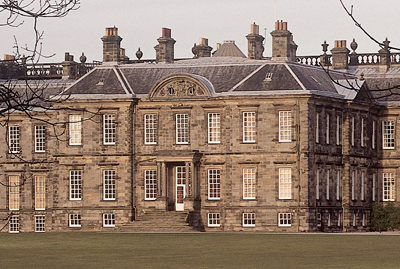Great British Architects: Sir William Bruce
Sir William Bruce introduced idiomatic neo-Classical architecture to Scotland


Sir William Bruce introduced idiomatic neo-Classical architecture to Scotland. His most important legacy was the idea of a compactly planned house on a rectangular plan two rooms deep, with restrained detailing and a hipped roof. Buildings of this kind (technically described as astylar double-pile houses) had been introduced to England by Inigo Jones in the early 17th century. At the time of their introduction to England (and then to Scotland), they stood in complete contrast to established traditions of house design; in both cases, grand residences previously comprised multiple ranges and often uneven roofscapes punctuated by towers.
Bruce's inspiration for astylar double-pile houses undoubtedly came from England. However, he sophisticated the form, with ideas taken from contemporary Dutch and French design. In conjunction with his building work, Bruce also introduced formal Baroque garden design to Scotland.
Early life
The circumstances of William Bruce's early life are imperfectly known. He was probably born in about 1630, the son of a Perthshire laird, and is perhaps the same William Bruce who was admitted to St Salvator's College at St Andrew's in 1637. There is no evidence for his early interests or architectural training, but, in 1659, he was involved in the negotiations to restore Charles II to the throne and is credited with having converted Gen Monk to the Royalist cause. This political activity demanded that he travel to Holland, and he may have taken the opportunity to visit France at this time. Following the Restoration, Bruce was knighted and, through the interests of the Earl (and later Duke) of Lauderdale, received appointment to several Government posts in Scotland. These allowed him to amass sufficient wealth to buy two estates, one in Fife in 1665, and another at Kinross 10 years later.
In 1668, Sir William received a baronetcy in acknowledgement of his new-found status. Meanwhile, during the 1660s, he visited England on several occasions and made one other documented ‘foreign journey' in 1663. On the former journeys, he may have familiarised himself with the English architectural developments that were to inform his own work.
Surveyor General
In 1671, Sir William was appointed Surveyor General and overseer of the king's buildings in Scotland on the considerable salary of £300 per annum. By this date, he had only recently undertaken his first private architectural projects, including the enlargement of Leslie House, Fife, begun in 1667.
Sign up for the Country Life Newsletter
Exquisite houses, the beauty of Nature, and how to get the most from your life, straight to your inbox.
His chief responsibility in office was the reconstruction of the medieval buildings at Holyroodhouse, the king's Edinburgh palace. Sir William worked on this project as he had at Leslie House with the King's Master Mason, Robert Mylne. Recasting the building in regular form, he created a palace with a castle-like exterior and an internal courtyard in the French Classical manner.
Over the early 1670s, Sir William's workload increased rapidly, but it was not until 1676-79 at Dunkeld and Moncreiffe, Perthshire, that he had the opportunity to design completely new buildings. Both houses were without Scottish parallel and looked back to the precedents of Inigo Jones' work in the 1620s. They were neo-Classical buildings two rooms deep on compact rectangular plans with hipped roofs and restrained detailing: the astylar double-pile house.
Later work
The death of Charles II in 1685 was a severe blow for Sir William. Henceforth, he was viewed with suspicion by the Government and his political career effectively came to an end.
From 1686, he focussed his attention on rebuilding Kinross and its surrounding gardens. Meanwhile, he continued to undertake other private house commissions, such as the surviving Hopetoun House, West Lothian, begun in 1699. It is apparent from surviving documentation that Sir William was widely consulted on building projects by the Scottish nobility and aristocracy. It may be the case that his list of attributed works, therefore, constitutes only a fragment of what he designed.
In addition to his architectural work, Sir William was also an important figure in Scottish landscape gardening and brought the formal Baroque garden to Scotland. His garden plans are laid out along a single axis that terminates on a distant feature. At Kinross, he used Loch-leven Castle on its island. Sir William died ‘at a very advanced age' on January 1, 1710, and is buried in his family vault at Kinross.
Country Life is unlike any other magazine: the only glossy weekly on the newsstand and the only magazine that has been guest-edited by HRH The King not once, but twice. It is a celebration of modern rural life and all its diverse joys and pleasures — that was first published in Queen Victoria's Diamond Jubilee year. Our eclectic mixture of witty and informative content — from the most up-to-date property news and commentary and a coveted glimpse inside some of the UK's best houses and gardens, to gardening, the arts and interior design, written by experts in their field — still cannot be found in print or online, anywhere else.
-
 About time: The fastest and slowest moving housing markets revealed
About time: The fastest and slowest moving housing markets revealedNew research by Zoopla has shown where it's easy to sell and where it will take quite a while to find a buyer.
By Annabel Dixon
-
 Betty is the first dog to scale all of Scotland’s hundreds of mountains and hills
Betty is the first dog to scale all of Scotland’s hundreds of mountains and hillsFewer than 100 people have ever completed Betty's ‘full house’ of Scottish summits — and she was fuelled by more than 800 hard boiled eggs.
By Annunciata Elwes